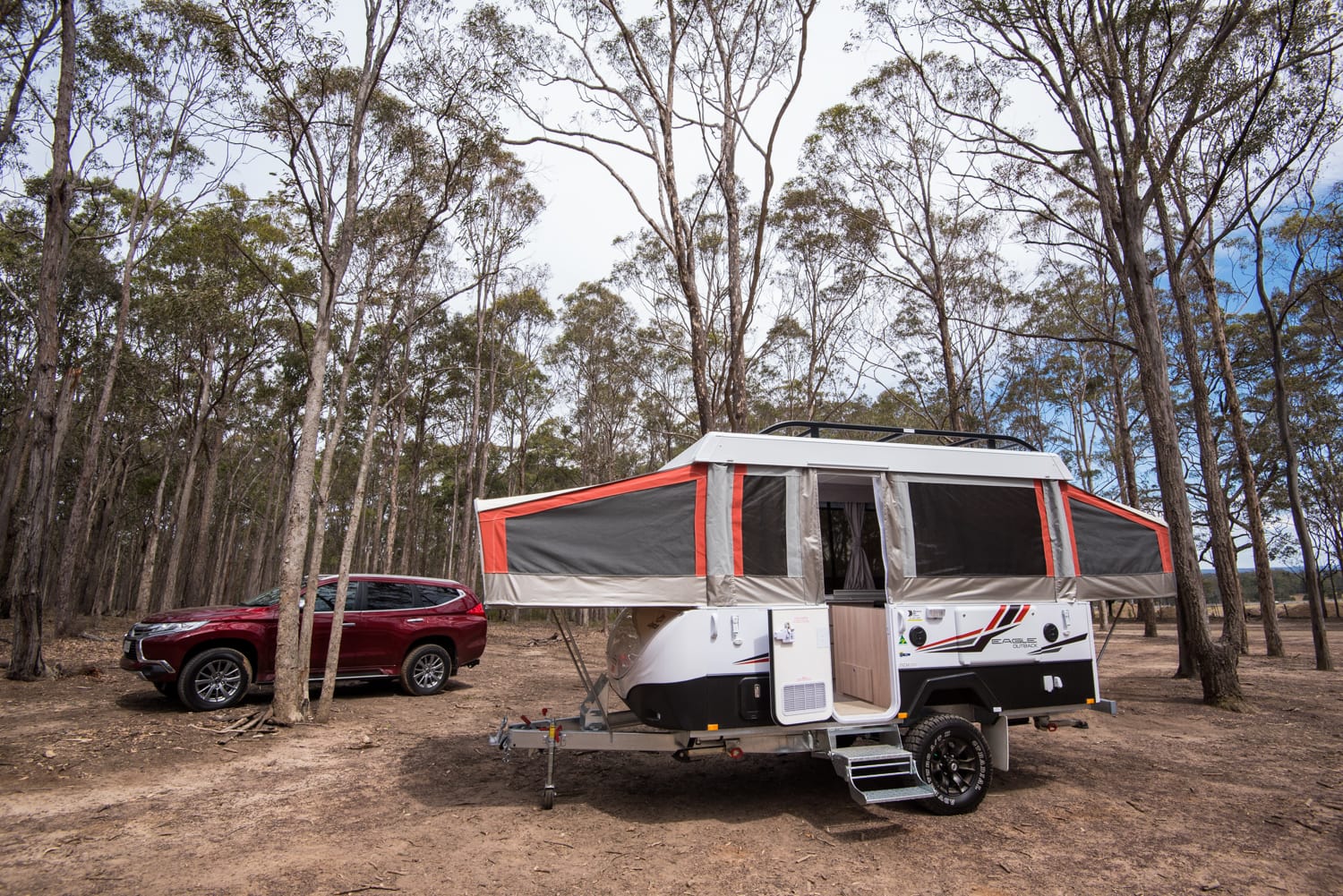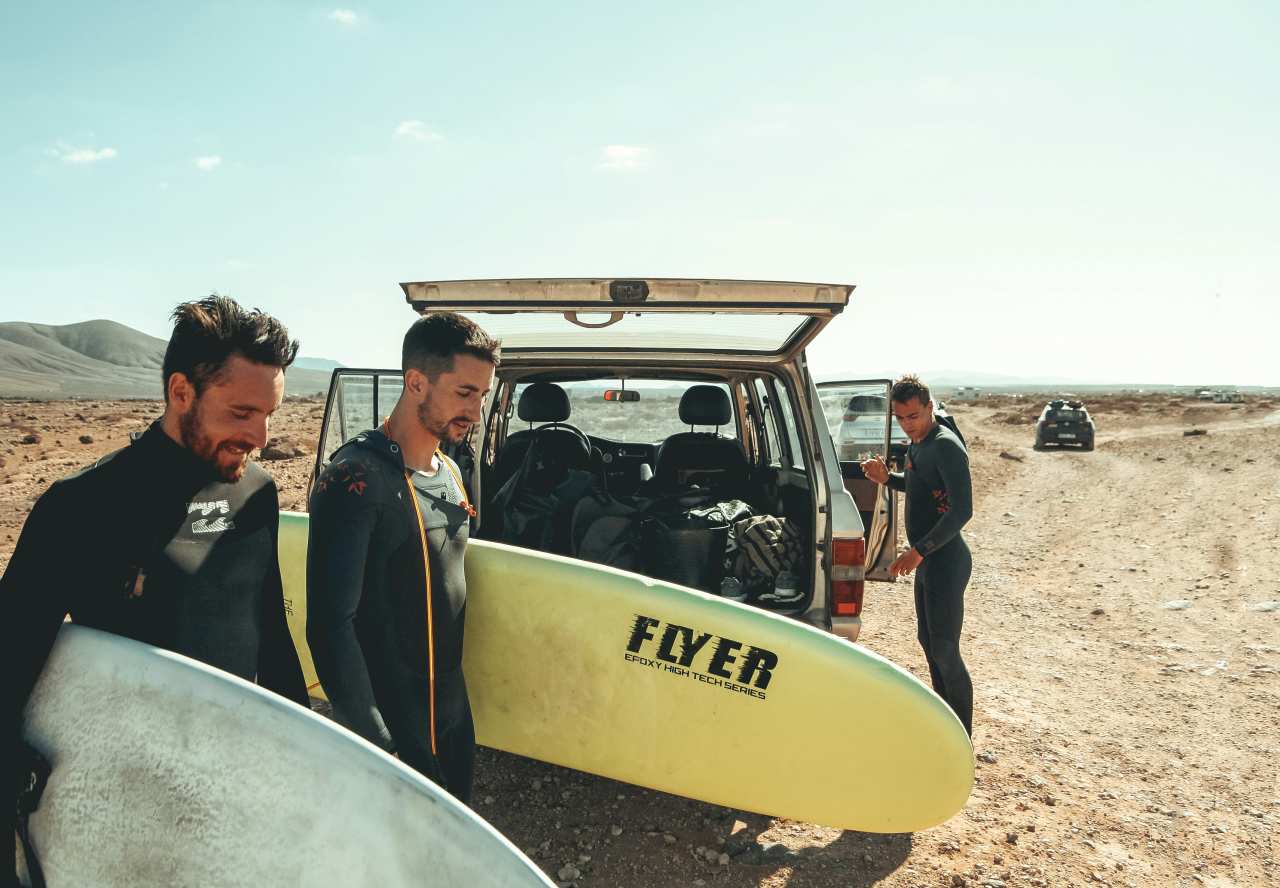People with camper-trailers are increasingly looking to push their travel boundaries and so they head off the bitumen, onto dirt roads and go bush.
But on-road camper-trailers are not suited to cope with the extra stresses that dirt-road or gravel-track driving bring, which is why campers better equipped for light-duty bush driving, such as Jayco’s Outback versions of its models, are finding favor with buyers.
We took an Eagle Outback into the bush to check it out.

How big is this camper-trailer? How much does it weigh?
| Length | 5060mm |
| Width | 2240mm |
| Height | 1910mm |
| Weight (Tare/ATM/Tow ball) | 1270kg / 1570kg / 150kg |
The Eagle Outback (from $28,266; our test camper was $32,373) has travelling dimensions of 5060mm long, 1910mm high and 2240mm wide. Its tare weight is 1270kg.
When set up, its length extends to 6200mm, 4040mm (in the body) and the interior tops out at 2070mm high.
Our test camper had the optional roof racks so was a touch taller than standard models.
Jayco reckons the Eagle Outback can accommodate two families, sleeping “four adults and two children, with an option to sleep a third child”.
How easy is it to tow?

This single-axle camper – at 5060mm long (including drawbar), 1910mm high, 2240mm wide, and with a 1270kg tare weight – towed smoothly behind the Mitsubishi Pajero Sport we used on this review.
It sat snug and steady on the towball (with a 150kg download) during open-road driving, as well as during short sections of slightly bumpy gravel track and undulating dirt road.
The Eagle Outback has a hot dip galvanised Endurance Chassis riding on Jayco’s own JTech coil-spring suspension set-up.
Please note: Jayco’s Outback models are designed and engineered for, at worst, dirt roads and gravel roads, not 4WD tracks. Do not think that because these campers have been branded ‘Outback’ that they are actually able to tackle hard-core off-roading.
How easy is it to set up?

Jayco camper-trailer models follow a similar set-up process and one which is, even on the first outing, easy enough and quick.
Unclip a latch near each top corner of the trailer’s body, remove the winder handle from the camper’s rear storage space, lock that winder into position – there’s a space for it on the camper’s rear end – and wind away.
Your efforts will raise the Eagle’s roof until the support bars at each corner are at full lock-out.
Roll the bed out at each end, then take the bed support struts, which are stored underneath the mattresses, and lock them into place on each bed base and corresponding point on the camper body.

Then pull the canvas down and over the edge of the beds and secure that in place with velcro strips.
In very basic terms, the rest of the process involves putting in place the interior ceiling poles for each bedroom (easier if you’ve left some slack in the canvas walls), and rearranging furniture from its travel position into its camp-ready position.
How practical is the space inside?

These Jayco camper-trailers have a familiar touring-friendly floor-plan – check out the accompanying photos for proof of that – and most adhere to a similar approach to interior functionality – neat and simple – and that’s well suited to those who venture off the blacktop and hit the dirt.
Interior height is 2070mm, standard for campers of this type, so there’s plenty of stretch space for those of us not gifted with the vertical inches of Collingwood’s Mason Cox. Bench height, also standard for a camper-trailer, remains just lower than an average bloke’s hip so stooping to work in the kitchen is still an issue, but that’s part and parcel of the lifestyle, so stop whinging and get used to it.
Looking from the door, to the left is the front bed and club lounge; along the wall is the kitchen area (replete with four-burner stove, Dometic 95-litre fridge*, storage drawers and pantry); and to the right is the rear bed and dinette area. (* Outback models get the 95-litre fridge; Touring models get the 90-litre fridge.)
Overhead interior lighting includes LEDs for the main area and reading lights for the beds; there’s a fan for the beds.
There are also power points and USB port.
What are the beds like?
Jayco beds have innerspring mattresses – cushy enough – and the bases are unsealed ply.
The camper’s front bed is 1460mm wide; the rear one is 1140mm wide; a bit narrower than the 1310mm-wide rear bed in our most recent Jayco tester, the top-spec Swan, but not even really noticeable even when you’re on it. Still, put the triathletes down the back; the Crossfitters up the front.
The bedrooms each have a curtain to close off the space and, of course, canvas zippered windows and mesh screens.
This camper’s converted beds – which emerge from rearranging the club lounge (with bed converter option, which our test camper had) and dinette area (as standard) – are for children or that mate of yours who doubles as a circus midget.
What’s the kitchen like?

A big plus to this tester is that as well as the kitchen area inside – with stainless-steel sink, four-burner stove, fridge and bench space – it has the optional two-burner stove on a pull-out slide on the Eagle Outback’s front left-hand exterior wall.
Buyers are able to upgraded this camper’s kitchen with a microwave and hot-water service.
What options are available for it?

There are a stack of accessories available; an air conditioner, awning walls and bike racks are all options for Outback versions of Jayco campers.
We’d certainly go for the BBQ slide-out that our test camper had.
Any potential issues with it?

One of the minor issues with Jayco’s Outback range of camper-trailers is that a few people will see only the ‘Outback’ bit in the model’s name, they won’t read the warranty fine print, they’ll ignore the salesman’s advice and they’ll falsely assume that their brand-new off road camper is capable of heading into true 4WD country.
Jayco’s Outback versions of its campers, according to its warranty, are “for limited unsealed road usage” and “under no circumstances” should they “be exposed to water crossings at, or above, body floor level”. Outback campers “are not designed for hard impact or heavy landings or severely rutted roads or tracks”, the warranty states, and they “are not designed for use on four wheel drive only tracks”.
Also, we’d like to see a microwave as standard at this price-point.
Verdict
The Jayco Eagle Outback, for me, is an example of a camper-trailer getting closer to what I reckon a truly off-road-capable Jayco camper will be like.
There's nothing in Jayco's current line-up that offers comfort and full functionality and is also capable of tackling decent off-roading, so we're looking forward to testing Jayco's first line-up of dedicated off-road campers, including the JTrak Outback and Outback X.
Is a camper-trailer's off-road ability important to you? Tell us what you think in the comments section below.
| Jayco Eagle Outback specifications | |
| Warranty | 24 months, 3-years Roadside Assist |
| Sleeps | Seven |
| Water capacity | 82L / n/a |











.jpg)

